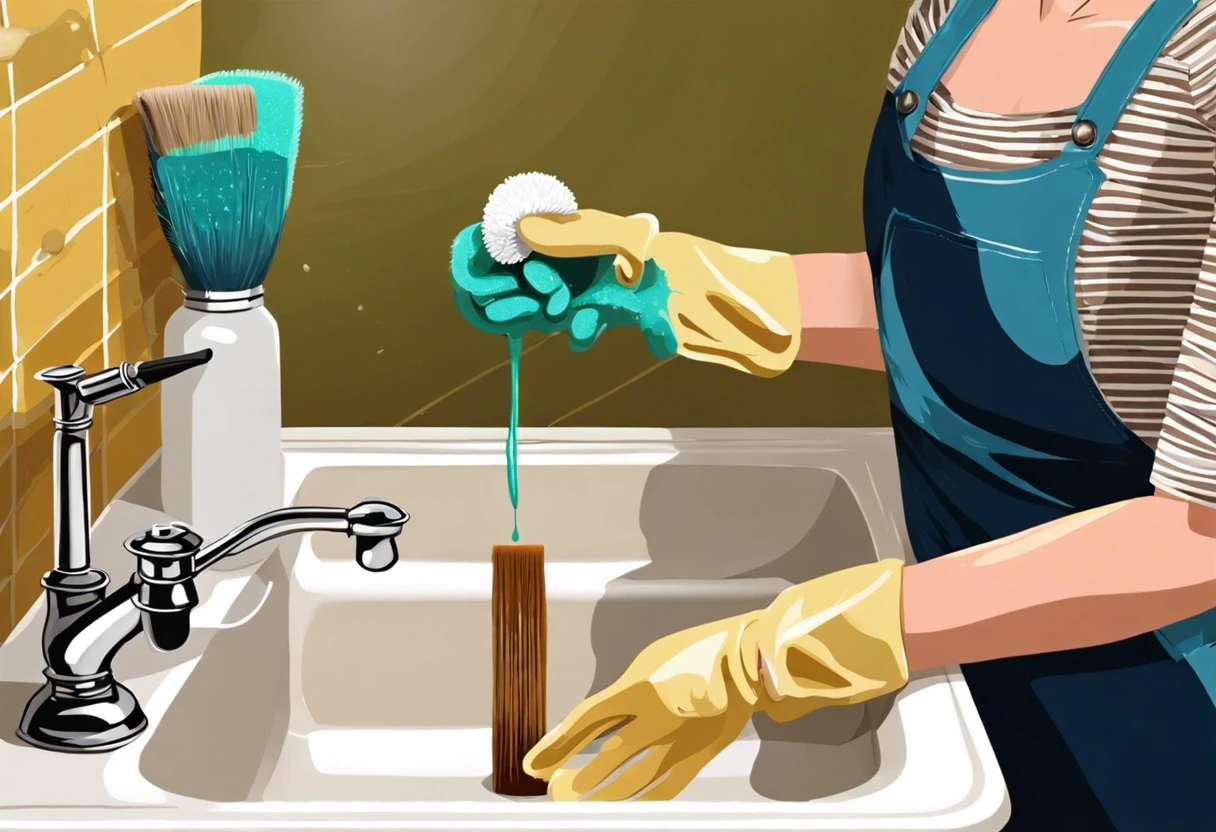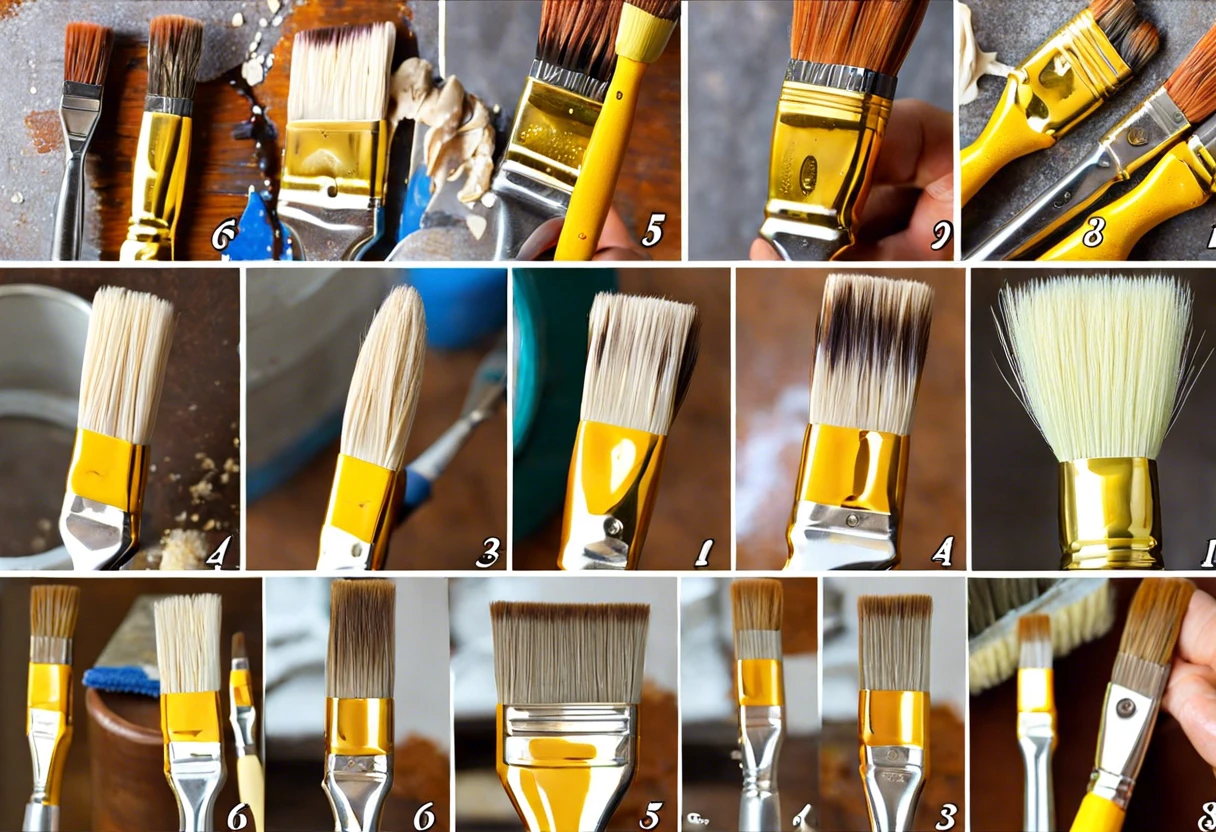How Do You Clean Oil Based Paint Brushes?
Published on: March 11, 2025 | Last Updated: January 7, 2025
Written By: Alisha Winters
Oil-based paint brushes are tools that help you put color on walls or canvases. They’re special because they hold paint made with oil, which makes the colors look bright and shiny!
So, how do you clean oil based paint brushes? It’s super important to keep your brushes clean. Trust me, when I first started painting, I didn’t clean my brushes right, and it was a nightmare. Cleaning them properly keeps them soft and ready for the next time you paint.
In this article, I’ll cover preparation before cleaning, a step-by-step guide on how to clean oil paint brushes, types of brushes and their care, and common issues you might face while washing. Get ready to learn everything about how do you clean oil based paint brushes!
Contents
- 1 How Do You Clean Oil-based Paint Brushes?
- 2 What Are Oil-based Paint Brushes?
- 3 Preparation Before Cleaning Oil-based Paint Brushes
- 4 Step-by-step Guide to Cleaning Oil-based Paint Brushes
- 5 Types Of Oil-based Paint Brushes and Their Care
- 6 Factors Affecting the Cleaning Process Of Oil-based Paint Brushes
- 7 Common Issues Encountered When Cleaning Oil-based Paint Brushes
- 8 Finishing Touches: Ensuring Your Brushes Are Ready for Next Use
- 9 Essential Tips for Maintaining Your Oil-based Paint Brushes
- 10 Understanding Brush Care: The Importance of Regular Cleaning
- 11 Different Scrubbing Techniques Based on Brush Material
- 12 When to Replace Your Oil-based Paint Brushes
- 13 How Different Brush Shapes Impact Cleaning Methods
- 14 Frequently Asked Questions About Cleaning Oil-based Paint Brushes
- 15 Conclusion
- 16 Useful Resources
How Do You Clean Oil-based Paint Brushes?
To clean oil-based paint brushes, first wipe off excess paint with a rag. Dip the brush into solvent like mineral spirits, swirling it around. Next, rinse the brush thoroughly and reshape the bristles. Allow it to dry before storing. If you’re wondering about paint stains on clothing, you might want to check out how to remove paint stains.
The Finishing Touch
A freshly painted wall is a blank canvas. The best way to bring your room to life is with a single piece of statement art that ties everything together.
Browse Wall Art at Big Wall DecorWhat Are Oil-based Paint Brushes?
Oil-based paint brushes have bristles designed for oil paints. They typically feature natural fibers like hog bristles or synthetic materials, each offering a unique finish and paint flow.
Cleaning oil paint brushes can be challenging. Oil paint can be tough to remove, and keeping brushes clean affects your next project. I realized how important this was during my last painting session. When you need precise techniques for preparing your brushes, mastering oil-based paint activation can make a significant difference in your painting workflow.
I used oil-based paint brushes for a large canvas. Taking care of those brushes, especially cleaning oil-based paint brushes, saved me money and improved my artwork. I learned that thorough cleaning is vital to maintain brush shape and effectiveness—there’s nothing worse than starting a new painting with hardened paint on your tools! When exploring different painting techniques, I discovered some interesting alternatives like painting on unconventional surfaces.
Preparation Before Cleaning Oil-based Paint Brushes
What do you need to get started?
- Mineral Spirits: You need a solvent like Bob Smith’s Mineral Spirits. It’s essential for breaking down the oil paint.
- Brush Cleaner: Consider products like Winsor & Newton Brush Cleaner to soften and loosen paint from the bristles effectively.
- Lint-Free Cloth: Grab a cloth like the Duster Microfiber Cleaning Cloth. It’s important for wiping excess paint from brushes.
- Gloves: Use nitrile gloves, such as AMMEX X3 Dutral, to protect your hands from harsh chemicals.
You should now have a good understanding of preparing for cleaning oil-based paint brushes. In the next part, we’ll discuss the cleaning process step-by-step.
Also See: Can You Get Paint Off Clothes? Quick Tips!

The Finishing Touch
A freshly painted wall is a blank canvas. The best way to bring your room to life is with a single piece of statement art that ties everything together.
Browse Wall Art at Big Wall DecorStep-by-step Guide to Cleaning Oil-based Paint Brushes
Here’s how to clean oil paint brushes effectively.
-
Choose the Right Solvent
Select a solvent that dissolves oil paint effectively, such as mineral spirits or turpentine. Both options break down paint without damaging the bristles.
I prefer mineral spirits for their less toxic cleaning method. Use about 500 mL (2 Cups) of your chosen solvent to start with one brush at a time.
-
Rinse the Brush With Solvent
Submerge your brush in the solvent and swish it gently for about one minute to lift off the paint. If your brush is heavily soiled, use a second container; repeat the process until the solvent appears clear. When working with different wood types like cedar, you might need specific painting techniques to prepare cedar surfaces effectively.
This step may require some trial and error, so don’t rush. Dispose of the solvent responsibly to ensure safety and environmental stewardship.
-
Use a Brush Comb or Cleaning Tool
Comb through the bristles with a brush comb or cleaning tool, starting near the ferrule (Metal Part) and working toward the tips. This helps dislodge any remaining paint particles.
I’ve had great success with a fine-toothed comb to avoid damaging the brush. If the bristles feel stiff, dip the comb in fresh solvent beforehand to ease the process.
-
Wash the Brush With Soap and Water
After removing most of the paint, wash the brush in warm, soapy water. Use a mild dish soap mixed with warm water, swirling the brush until lather forms; this removes any solvent residues.
Rinse thoroughly under running water. Repeat the soap wash if you notice any residual paint or odor in the bristles.
-
Reshape and Dry the Brush
After cleaning, reshape the brush head to its original form. Gently squeeze out excess water without pulling on the bristles, as this can cause damage.
Let the brush dry flat, hang it upside down, or use a special brush holder for best results. Keep it out of direct sunlight to prevent bristle deformation; ideally, let it dry for 24 hours.
We’ve wrapped up the process of cleaning oil-based paint brushes here. Let us turn our attention to the various types of these brushes and how to care for them.
Types Of Oil-based Paint Brushes and Their Care
Let’s look at the different types of oil-based paint brushes: flat, round, filbert, and angled brushes.
-
Flat Brush
Flat brushes have a wide, rectangular shape. They’re ideal for broad strokes and filling large areas, making them great for backgrounds and base coats.
-
Round Brush
Round brushes have a pointed tip and hold a good amount of paint. They’re perfect for detail work and can create fine lines when cleaning oil-based paint from brushes.
-
Filbert Brush
Filbert brushes combine a flat end with rounded edges. This type is excellent for blending strokes and softening harsh lines, which is helpful when washing oil paint off brushes.
-
Angled Brush
Angled brushes have slanted edges that allow precision in cutting in and corner work. This is useful for getting into tight spaces while caring for your oil paint brushes.
Through trial and error, I’ve found that I enjoy using filbert brushes. Their ability to blend colors seamlessly enhances my painting experience.
You should now have a good understanding of oil-based paint brush types and their maintenance. In the next part, we’ll discuss cleaning process considerations.
Factors Affecting the Cleaning Process Of Oil-based Paint Brushes
What factors impact how you clean your oil-based paint brushes?
-
Type of Solvent: Different solvents, like turpentine or mineral spirits, affect cleaning effectiveness.
-
Brush Material: Natural or synthetic bristles require different cleaning techniques.
-
Amount of Paint: A heavily paint-covered brush needs more effort and possibly multiple washings.
-
Time Elapsed After Use: Allowing paint to dry makes cleaning brushes harder; clean them ASAP!
That covers the elements influencing the cleaning of oil-based paint brushes. Let’s now take a look at typical challenges faced during the cleaning process.

Common Issues Encountered When Cleaning Oil-based Paint Brushes
My friend struggled with hardened paint stuck in her oil-based brushes. Frustrating, right? It took persistent scrubbing to clean them.
To fix this, she soaked the brushes in solvent—specifically mineral spirits—for 30 minutes. This breaks down the paint effectively. Remember, always use 0.5 L to 1 L (17 to 34 Fl Oz) of solvent for the best results! When cleaning delicate paintbrushes, you might want to explore professional brush maintenance techniques.
Finishing Touches: Ensuring Your Brushes Are Ready for Next Use
After you’re done with your oil-based paint brushes, rinse them with mineral spirits immediately. Soak them for about 15-20 minutes to remove stubborn paint residue.
Inspect your brushes for frayed bristles or hardened paint. Check for clogs near the ferrule (Metal Band); use a colorless solvent, like turpentine, if needed.
If you’re experienced, consider reshaping your brush bristles with a synthetic conditioner. Apply a few drops and use your fingers to mold them before storage.
The Finishing Touch
A freshly painted wall is a blank canvas. The best way to bring your room to life is with a single piece of statement art that ties everything together.
Browse Wall Art at Big Wall DecorEssential Tips for Maintaining Your Oil-based Paint Brushes
Keep your brushes in top shape with these simple tips!
-
Clean Brushes Immediately
Always clean your oil-based paint brushes right after use. This prevents paint from hardening and makes the cleaning process much easier.
-
Avoid Submerging Bristles in Solvent
Never soak the bristles in solvent. This can lead to damage. Instead, dip the ferrule (the metal part) to keep the bristles intact.
-
Add a Conditioning Agent
Consider using a brush conditioner after cleaning. A few drops help keep the bristles soft and flexible, extending the brush’s lifespan.
-
Store Properly
Store your cleaned brushes horizontally or hang them upside down. This maintains brush shape and prevents water from settling in the ferrule.
Understanding Brush Care: The Importance of Regular Cleaning
Why is regular cleaning so crucial for your oil-based paint brushes?
Regular cleaning not only extends the life of your brushes but also ensures quality results in your projects. Here’s why you should clean those brushes frequently:
- Prevents Hardening: Oil paint can harden quickly. Cleaning brushes right after use stops paint from setting, making future usage more efficient.
- Maintains Brush Shape: Brushes can lose their shape if paint residue accumulates. Keeping them clean helps maintain their original form for better application.
- Improves Paint Quality: A dirty brush can mix unwanted colors into your project. Cleaning ensures the purity of your paint, giving your artwork a professional finish.
Different Scrubbing Techniques Based on Brush Material
Did you know that the material of your brush changes how you clean it? Here’s a breakdown.
| Brush Material | Cleaning Technique | Additional Notes |
|---|---|---|
| Hog Bristle | Rinse with mineral spirits and comb carefully. | Natural fibers are durable but need gentle care. |
| Synthetic Fiber | Soak in soap and warm water followed by a solvent rinse. | Synthetic bristles are resilient; use less harsh methods. |
| Blended Fibers | Swirl in solvent, then wash with soap. | Versatile and can handle different paint types. |
| Fan Brush | Gently swirl in solvent to retain shape and usability. | Care is essential to maintain the fan shape. |
When to Replace Your Oil-based Paint Brushes
Not sure when to give up on a brush? Here are some signs!
- Frayed Bristles: If the bristles are split, you can’t achieve clean lines.
- Loss of Shape: Brushes that no longer hold their form won’t apply paint well.
- Stiffness: If cleaning won’t soften them, it’s time for a replacement.
- Paint Residue: Persistent paint buildup signals it’s beyond rescue.
How Different Brush Shapes Impact Cleaning Methods
Brush shape affects how you clean them. Let’s break it down!
| Brush Shape | Cleaning Method | Notes |
|---|---|---|
| Flat Brush | Swipe back and forth in solvent | Effective for removing paint from wide surfaces. |
| Round Brush | Swirl in solvent, then clean inner bristles | Focus on getting paint out from the tip. |
| Filbert Brush | Use a comb after solvent soak | Blending requires extra care to maintain shape. |
| Angled Brush | Clean edges carefully with a brush comb | Avoid damage by being gentle on the angle. |
Frequently Asked Questions About Cleaning Oil-based Paint Brushes
How Often Should I Clean Oil-based Paint Brushes?
Yes, you should clean oil-based paint brushes after each use. Cleaning brushes regularly prevents paint from hardening, which can ruin bristles and save you money on replacements. It’s a good habit to clean them immediately after finishing your project.
Can I Use Water to Clean Oil-based Paint Brushes?
No, you can’t use water to clean oil-based paint brushes. Water won’t dissolve oil-based paints, leading to brush damage and wasted paint. Instead, use mineral spirits or paint thinner. These solvents break down the paint effectively. If you’re curious about alternative painting techniques and surface preparation, check out how acrylic paint works on wood.
What Happens if I Don’t Clean My Oil-based Paint Brushes?
If you don’t clean your oil-based paint brushes, they’ll get clogged and become unusable. Dried paint stiffens the bristles, making them tough to use again. In fact, not cleaning them can double your costs since you’ll need to buy new brushes. When exploring different painting techniques, you might wonder about painting alternative surfaces creatively.
Is It Possible to Revive Old, Caked-over Brushes?
Yes, you can revive old, caked-over brushes. Soak them in solvent for a few hours until the paint softens, then reshape the bristles. With patience, you can restore brushes that seemed lost cause, prolonging their life.
What Safety Precautions Should I Take While Cleaning Brushes?
You should always wear gloves and work in a well-ventilated area while cleaning oil-based paint brushes. Solvents emit strong fumes, and prolonged exposure can harm your health. Having proper safety gear ensures a safer and more comfortable cleaning process. When selecting the right tools for paint maintenance, I recommend exploring professional paint brush techniques.
Can Oil Paint Brushes Be Reused After Cleaning?
Yes, oil paint brushes can absolutely be reused after cleaning. Properly cleaned brushes maintain their shape and functionality, allowing you to continue creating vibrant artworks. In fact, with good care, your brushes can last years.
What’s the Best Way to Store Cleaned Oil-based Paint Brushes?
The best way to store cleaned oil-based paint brushes is horizontally. Lay them flat and reshape the bristles to maintain their form. This prevents moisture build-up and protects the brush tips from damage during storage.
Also See: How to Paint 3D Printed Models? Easy Tips!
Conclusion
We covered items like preparation steps, a step-by-step guide, types of brushes, factors affecting cleaning, common issues, and finishing touches for oil-based paint brushes.
To clean oil-based paint brushes, simply use mineral spirits or paint thinner, repeatedly wiping the brushes on a cloth until clean. This method efficiently removes that stubborn oil paint, preparing your brushes for future use.
For additional insights and expert advice, visit our homepage at Paint Answers.
Useful Resources
- Loomis, A. (2011). Figure Drawing for All It’s Worth. New York, NY: Titan Books.
- How to Clean Oil Paint Brushes | Rileystreet – Rileystreet Art Supply
- How to Clean Oil Stain Finish Brushes | Woodworking
- How to Clean Paint Brushes – The Home Depot
Experienced interior designer with 15+ years in transforming spaces, blending artistry with expertise in color and design. Rhode Island School of Design graduate, specializing in restorations and modern makeovers.
Cleaning, Topics









